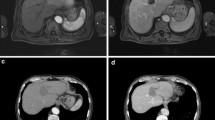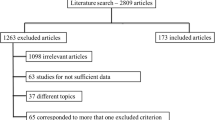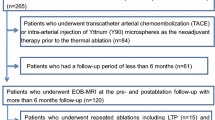Abstract
Purpose
To assess the diagnostic accuracy of contrast-enhanced ultrasound (CEUS), contrast-enhanced multiphase CT (CECT), and gadoxetic acid-enhanced MRI (EOB-MRI) in identifying residual tumor in the subacute follow-up of patients with malignant hepatic tumors treated by irreversible electroporation (IRE).
Methods
We enrolled 16 patients with 21 hepatic lesions treated by IRE and examined by CEUS and CECT at 1 day after IRE and by EOB-MRI at 7 days after IRE. Follow-up examinations by EOB-MRI or CECT and CEUS were performed at 3-month intervals. Two radiologists independently reviewed the images and assessed the probability of residual tumor using a five-point scale with receiver operating characteristic (ROC) curve analysis. The sensitivity and specificity were also evaluated. Verifiable local recurrence was assessed using follow-up imaging as the reference standard.
Results
The mean area under the ROC curve was significantly higher for CEUS (0.980) than for CECT (0.742, P < 0.01) and EOB-MRI (0.806, P < 0.01), as were the sensitivity and specificity (mean 85.7 and 85.7% for CEUS, respectively, vs 64.3 and 46.4% for CECT and 78.6 and 64.3% for EOB-MRI).
Conclusion
CEUS was found to be superior to CECT and EOB-MRI for the diagnosis of residual tumor in the subacute phase following IRE.



Similar content being viewed by others
References
Davalos RV, Mir IL, Rubinsky B. Tissue ablation with irreversible electroporation. Ann Biomed Eng. 2005;33:223–31.
Ahmed M, Goldberg SN. Thermal ablation therapy for hepatocellular carcinoma. J Vasc Interv Radiol. 2002;13:S231–44.
Boaz TL, Lewin JS, Chung YC, et al. MR monitoring of MR-guided radiofrequency thermal ablation of normal liver in an animal model. J Magn Reson Imaging. 1998;8:64–9.
Kingham TP, Karkar AM, D’Angelica MI, et al. Ablation of perivascular hepatic malignant tumors with irreversible electroporation. J Am Coll Surg. 2012;215:379–87.
Lee YJ, Lu DS, Osuagwu F, et al. Irreversible electroporation in porcine liver: short- and long-term effect on the hepatic veins and adjacent tissue by CT with pathological correlation. Investig Radiol. 2012;47:671–5.
Maor E, Ivorra A, Leor J, et al. The effect of irreversible electroporation on blood vessels. Technol Cancer Res Treat. 2007;6:307–12.
Cannon R, Ellis S, Hayes D, et al. Safety and early efficacy of irreversible electroporation for hepatic tumors in proximity to vital structures. J Surg Oncol. 2013;107:544–9.
Goldberg SN, Grassi CJ, Cardella JF, et al. Image-guided tumor ablation: standardization of terminology and reporting criteria. Radiology. 2005;235:728–39.
Sugimoto K, Moriyasu F, Shiraishi J, et al. Assessment of arterial hypervascularity of hepatocellular carcinoma: comparison of contrast-enhanced US and gadoxetate disodium-enhanced MR imaging. Eur Radiol. 2012;22:1205–13.
Sainani NI, Gervais DA, Mueller PR, et al. Imaging after percutaneous radiofrequency ablation of hepatic tumors: part 1, normal findings. AJR Am J Roentgenol. 2013;200:184–93.
Nakazawa T, Kokubu S, Shibuya A, et al. Radiofrequency ablation of hepatocellular carcinoma: correlation between local tumor progression after ablation and ablative margin. AJR Am J Roentgenol. 2007;188:480–8.
Sugimoto K, Moriyasu F, Kobayashi Y, et al. Irreversible electroporation for nonthermal tumor ablation in patients with hepatocellular carcinoma: initial clinical experience in Japan. Jpn J Radiol. 2015;33:424–32.
Catalano O, Izzo F, Vallone P, et al. Integrating contrast-enhanced sonography in the follow-up algorithm of hepatocellular carcinoma treated with radiofrequency ablation: single cancer center experience. Acta Radiol. 2015;56:133–42.
Granata V, Fusco R, Catalano O, et al. Percutaneous ablation therapy of hepatocellular carcinoma with irreversible electroporation: MRI findings. AJR Am J Roentgenol. 2015;204:1000–7.
Guo Y, Zhang Y, Nijm GM, et al. Irreversible electroporation in the liver: contrast-enhanced inversion-recovery MR imaging approaches to differentiate reversibly electroporated penumbra from irreversibly electroporated ablation zones. Radiology. 2011;258:461–8.
Acknowledgements
This work was supported by MEXT KAKENHI Grant Number 26865030. The authors would like to thank Dr. Toru Saguchi for image interpretation.
Author information
Authors and Affiliations
Corresponding author
Ethics declarations
Conflict of interest
The authors declare that they have no conflicts of interest.
Human rights statements and informed consent
All procedures followed were in accordance with the ethical standards of the responsible committees on human experimentation (institutional and national) and with the Helsinki Declaration of 1975, as revised in 2008. Informed consent was obtained from all patients before inclusion in the study.
About this article
Cite this article
Sugimoto, K., Moriyasu, F., Saito, K. et al. Multimodality imaging to assess immediate response following irreversible electroporation in patients with malignant hepatic tumors. J Med Ultrasonics 44, 247–254 (2017). https://doi.org/10.1007/s10396-016-0767-0
Received:
Accepted:
Published:
Issue Date:
DOI: https://doi.org/10.1007/s10396-016-0767-0




